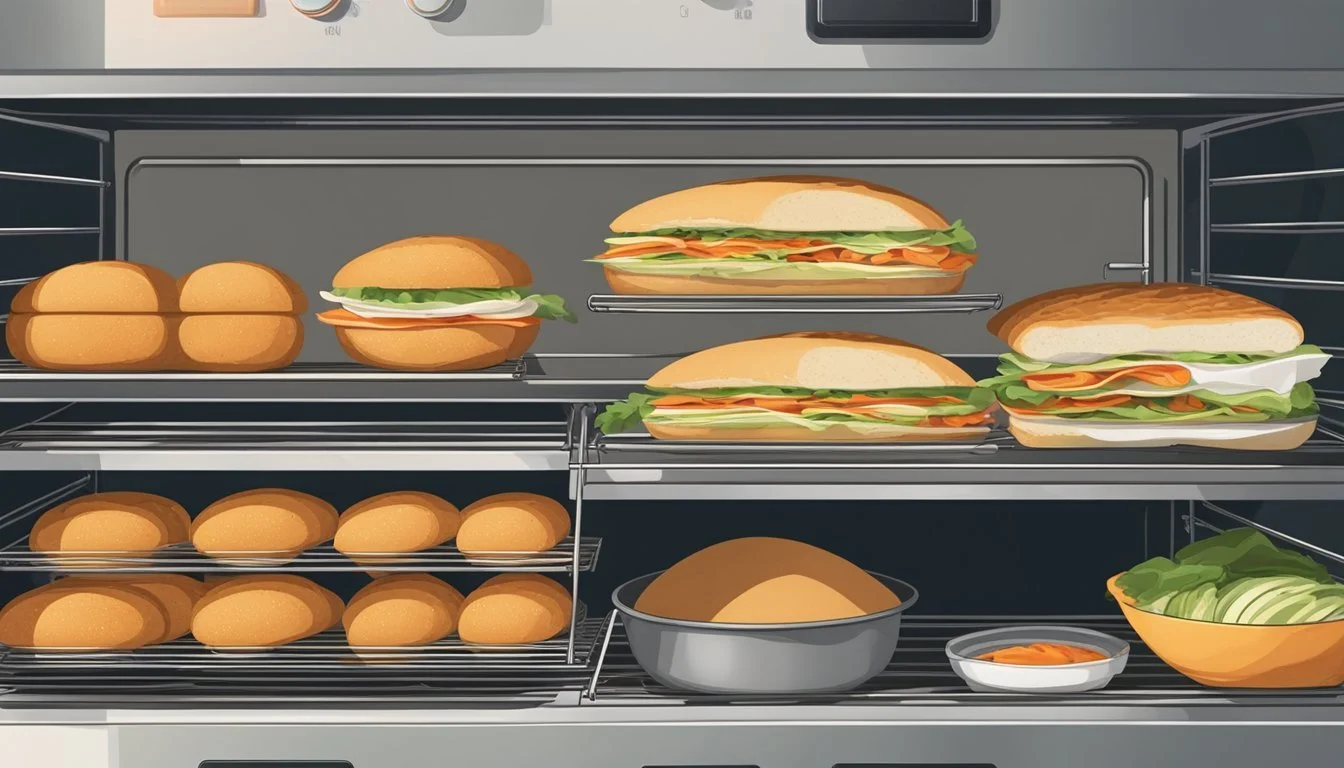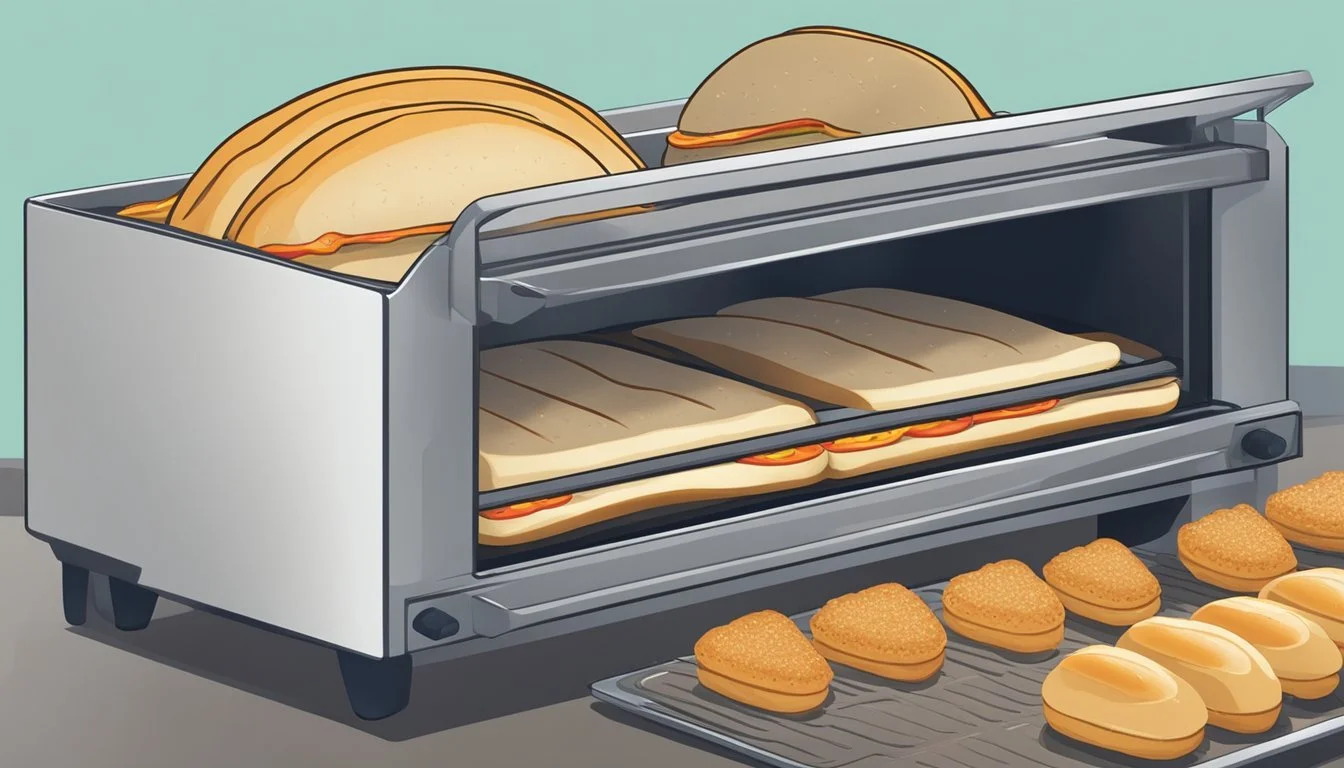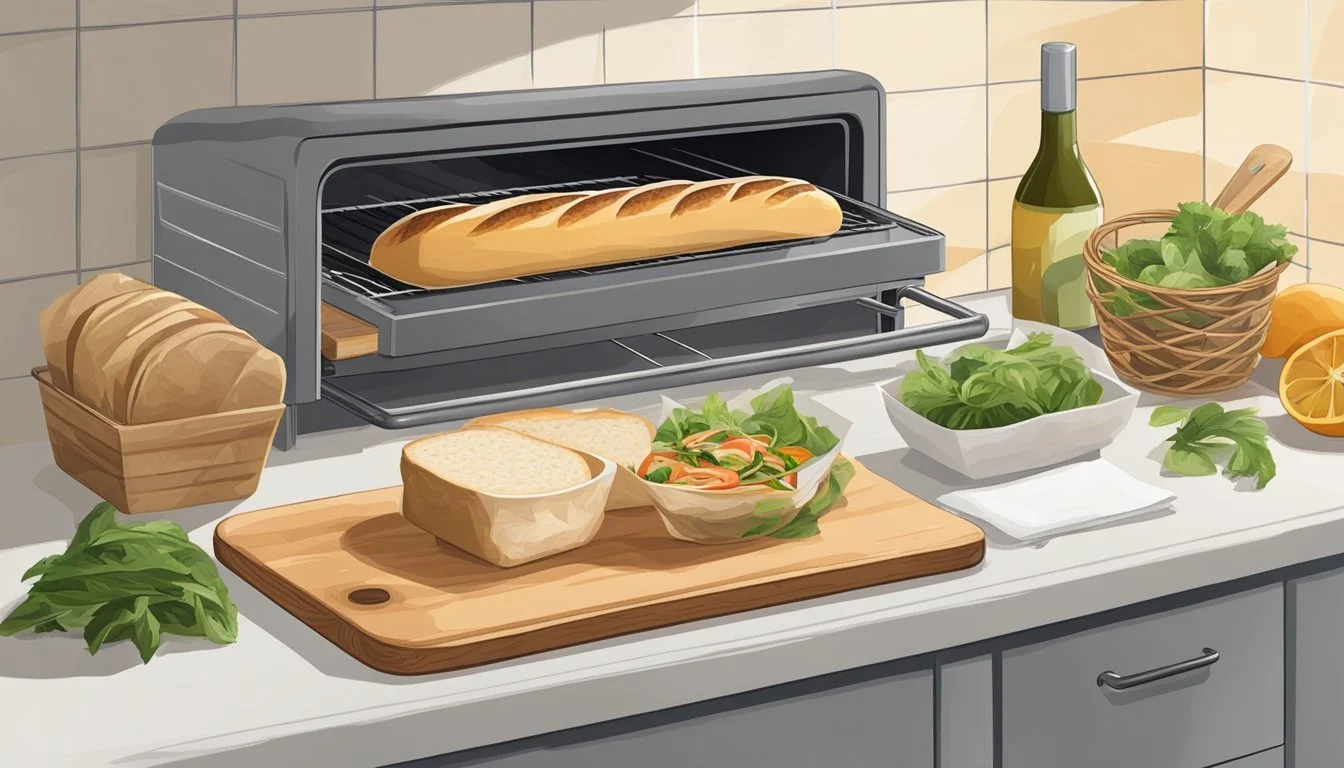Best Way to Reheat a Bánh Mì Sandwich for Optimal Crunch and Flavor Preservation
When attempting to reheat a bánh mì sandwich, the primary goal is to preserve the textural contrast that defines this Vietnamese classic: the crusty exterior of the bread (What wine goes well with bread?) against the tender meats and crisp, pickled vegetables (What wine goes well with pickled vegetables?) inside. Achieving that perfect balance of textures is pivotal; a properly reheated bánh mì can be nearly indistinguishable from one that is freshly made. The challenge lies in warming the internal ingredients without compromising the bread's delightful crunch.
Effective reheating methods take into account the various components of a bánh mì. Typically, this means removing the more delicate salad items such as lettuce, cucumber, and cilantro before heating. These ingredients are best added after the reheating process, ensuring they retain their freshness and crunch. Techniques for reheating include using an oven or toaster oven to gently warm the sandwich, often with the protection of aluminum foil to prevent the bread from charring, while retaining moisture in the fillings. Each method has its own nuances, and understanding them can lead to the reclamation of the vibrant flavors and textures of a bánh mì sandwich.
Understanding the Bánh Mì Sandwich
The Bánh Mì sandwich embodies a fusion of Vietnamese and French culinary traditions. It typically consists of a French baguette, known for its crispy crust and soft interior, which forms the foundation of the sandwich.
Key Ingredients:
Crusty Bread: The base of any Bánh Mì is a miniature French-style baguette.
Fillings: Common fillings include a variety of proteins such as pork, chicken, or tofu.
Fresh and Pickled Vegetables: Cucumber, cilantro, pickled carrots, and daikon radish add crunch and tang.
Sauces and Spreads: Liver pâté, mayonnaise, and spicy elements like chili sauce are often used.
The interplay between these elements delivers a complex texture and flavor profile. The Vietnamese sandwich is renowned for its balance of savory, sweet, and spicy notes, with the fresh and pickled elements providing a refreshing contrast.
Cultural Blending:
Vietnamese Cuisine: Famed for its emphasis on fresh ingredients and delicate spices.
French Cuisine: Introduced the baguette and pâté during the colonial period.
Crafting the perfect Bánh Mì is about maintaining the integrity of both Vietnamese and French influences. When reheating, the objective is to preserve the crispiness of the baguettes and the freshness of the ingredients.
Preparation for Reheating
A proper reheating process begins with preparation, ensuring that the distinct textures and flavors of a classic bánh mì are maintained. The bánh mì's bread, with its iconic crusty exterior and soft interior, is a centerpiece of the sandwich that requires special attention before reheating.
Ingredients Check
Before reheating, one needs to check the fillings of the bánh mì. Traditional Vietnamese bánh mì fillings include meat (often grilled pork, chicken, or pâté), pickled vegetables (such as daikon and carrot), cilantro, fresh herbs, and spreads like mayonnaise, butter, or pâté. Each of these ingredients will react differently to heat—with fresh vegetables and herbs losing their crispness and spreads becoming oilier. They should be temporarily removed and set aside if necessary to prevent soggy outcomes.
Preparing the Bread
The bread, typically a French baguette or bánh mì bread, is best reheated to get the ideal crusty texture. This involves either a conventional oven to reheat the bread evenly or brief use of a microwave with a damp paper towel to prevent it from drying out. Utilize a sharp knife to slice the bread adequately if it is to be toasted. This will ensure the heat permeates throughout the bread without overcooking or hardening.
Preheat the oven to 350°F (177°C) if using.
If microwaving, slice the sandwich portion into halves.
Sandwich Assembly Tips
After the bread has been reheated to a crispy exterior while maintaining a soft interior, it's time to re-assemble the sandwich:
Add the proteins: Reintroduce the meats or tofu to the crunchy bread.
Layer the vegetables: Insert the pickled vegetables carefully to prevent sogginess.
Garnish with herbs: Top with fresh cilantro and other herbs.
Spread: Finish by lightly spreading mayonnaise, butter, or pâté.
The fillings should be at room temperature or slightly warmed, so they don't cool the bread down too quickly. The size and scale of the fillings in relation to the bread should be balanced to ensure a consistent flavor in every bite.
Reheating Methods
To maintain the distinctive crusty texture of a Bánh Mì's bread during reheating, one must pay attention to temperature control and reheating techniques.
Using an Oven
One reheats a Bánh Mì in the oven by preheating it to 350°F. Place the sandwich on a baking sheet lined with parchment paper or a baguette pan to promote even heating. Covering the sandwich with aluminum foil can prevent the crust from burning. Allow it to warm for 10-15 minutes, checking occasionally to ensure the crust remains crispy without becoming overly dark.
Air Fryer Technique
An air fryer excels in keeping the crusty exterior of a Bánh Mì. Preheat the air fryer to 350°F before placing the sandwich inside. Due to its size, one may need to reheat the sandwich in parts if it does not fit whole. The high circulation of air helps toast the crust evenly, creating a crisp texture. The process typically takes around 6 minutes but may vary based on the air fryer model.
Microwave Considerations
Although not ideal for crusty textures, a microwave can be used for reheating Bánh Mì if done carefully. To avoid a soggy crust, one should set the microwave to a low power setting and heat in short intervals. The inclusion of a cup of water within the microwave can help manage steam levels and keep the bread's texture. After microwaving, it is beneficial to let the sandwich rest before consuming.
Stove Top Methods
The stove top offers a direct heating method using a pan to reheat Bánh Mì. One can wrap the sandwich in aluminum foil and place it over a low flame to gradually warm the fillings without compromising the crusty bread. Alternatively, for an even crisper crust, the sandwich can be toasted directly on the pan without foil for a brief time on both sides, monitoring closely to prevent charring.
Safeguarding the Crispiness
Maintaining the crusty texture of a Bánh Mì's bread while reheating is crucial. To ensure the bread remains crisp, one must pay attention to preheating, moisture control, and precise timing and temperature settings.
Preheating Essentials
Before reheating a Bánh Mì, preheating the appliance is a step one should never skip. Whether using an oven or a toaster oven, setting it to a temperature of 350°F ensures the bread starts to warm without immediate exposure to high heat, which can cause sogginess.
Oven: Preheat to 350°F before placing the sandwich inside.
Toaster Oven: Takes about 5-15 minutes to reach the right temperature.
Moisture Management
Managing moisture is key to keeping the Bánh Mì crusty. When using an oven or toaster, wrapping the bread in aluminum foil can prevent it from drying out, while strategically allowing some parts exposed can preserve its crispiness.
Aluminum Foil: Covering prevents direct heat but retains warmth.
Air Flow: In an air fryer, adequate space for circulation prevents steam from making the bread soggy.
Timing and Temperature Control
Finally, the duration and temperature of reheating play a crucial role. A Bánh Mì should be reheated at a moderate temperature for a specific time to crisp the exterior while preventing the inside from drying out.
Oven or Toaster Oven: 8-12 minutes of reheating is sufficient in most cases.
Air Fryer: Cook each side of the Bánh Mì for 3 minutes at 350°F.
Post-Reheat Enhancements
After carefully reheating a Bánh Mì to maintain the crusty bread, one can elevate the sandwich experience by adding fresh ingredients and adjusting sauces. These post-reheat enhancements bring back the freshness and balance the flavors to mimic an authentic, just-made Bánh Mì.
Additional Toppings and Condiments
Fresh Herbs: Sprinkle cilantro or other fresh herbs to reintroduce herbal brightness.
Pickle: Add pickled vegetables for a tangy crunch that contrasts with the warmed fillings.
Meats: Consider pork belly (What wine goes well with pork belly?) or additional meat cuts to replenish the sandwich's savory profile.
Pâté: A spread of pâté can be reapplied, if it was removed before reheating, to restore the essential creamy and rich dimension.
Sauce and Seasoning Adjustments
Sauce: Drizzle a touch more of the Bánh Mì’s signature sauce to ensure the sandwich is neither too dry nor lacking in flavor.
Sweet: For a sweet punch, a small amount of hoisin or plum sauce can be applied.
Tangy: To enhance the tanginess, consider a light splash of rice vinegar or additional pickled elements.
Seasoning: A light sprinkle of salt can balance the flavors, especially after adding fresh vegetables and herbs. Similarly, a pinch of pepper may be used to cut through the fat and complement the meat.
Storing and Handling Leftovers
Properly storing and reheating a bánh mì ensures the leftover sandwich maintains its signature warm, crisp texture.
Proper Storage Techniques
To preserve a leftover bánh mì, one must first let it cool to room temperature. Wrapping the sandwich in parchment paper followed by aluminum foil can help maintain its quality. The parchment paper absorbs excess moisture, while the foil protects the bread from drying out. It is crucial to store the bánh mì in the refrigerator, where it can stay fresh for up to 3 days.
Reheating from Refrigerated State
When it comes to reheating a refrigerated bánh mì, an oven provides the best results. Preheat the oven to 350°F, then remove any salad items from the sandwich to avoid sogginess. Reheat the bánh mì wrapped in foil for about 10 minutes, checking for warmth. If needed, remove the foil and heat for an additional 2-3 minutes for a crispier texture. Alternatively, microwaving can be quick, covering the sandwich in a damp paper towel and heating at medium power for brief intervals to avoid hardness.
Nutritional Aspects
When considering how to reheat a Bánh Mì sandwich to preserve its crusty texture, the nutritional content of the sandwich remains a consistent consideration. A traditional Bánh Mì typically includes a variety of vegetables, proteins, and carbohydrates, which contribute to its overall nutritional profile.
Calories: The calorie count for a Bánh Mì can vary, but on average, one might expect it to range between 300 to 500 calories depending on the fillings and size of the sandwich.
Carbohydrates: The baguette provides the bulk of the carbohydrates in a Bánh Mì sandwich. A standard Bánh Mì roll can contain between 50 to 60 grams of carbohydrates.
Fiber: Contributed by the vegetables such as carrots, cucumbers, and daikon radish, the fiber content aids in digestion.
Sodium: Cured meats (What wine goes well with cured meats?) and condiments like soy or fish sauce might elevate the sodium levels. Consumers should be mindful of this if they are watching their sodium intake.
Protein: It varies based on the choice of protein—commonly pork, chicken, or tofu—with an average serving contributing 20-30 grams of protein to the diet.
Fat: Fat content, often derived from the pâté and mayonnaise traditionally spread on the inside of the bread, can vary but contributes to the sandwich's flavor profile.
The table below summarizes these nutritional aspects:
Nutrient Approximate Amount Calories 300-500 Carbohydrates 50-60g Fiber Variable Sodium High in processed meats and sauces Protein 20-30g Fat Variable
Individuals can make healthier choices by opting for leaner proteins and including more vegetables to increase fiber and decrease the fat content in the sandwich.
Making Bánh Mì at Home
Creating an authentic bánh mì at home involves several steps, from crafting the perfect Vietnamese baguette to compiling a medley of fresh fillings. Adherence to the process and proper techniques ensure the signature crispy crust and fluffy interior.
Recipe and Ingredients
To embark on the bánh mì journey, one must gather the essentials for the Vietnamese baguette, which differs from its French counterpart with a lighter, airier texture. The priority lies in a combination of rice flour and all-purpose flour, instant yeast, sugar, salt, and warm water. For the fillings, options vary widely - common proteins include pâté, pork, chicken, or tofu, paired with pickled vegetables (carrots, daikon), cucumbers, cilantro, and spicy chilies. Condiments such as mayonnaise or a soy sauce blend add flavor depth.
Quantity Ingredient Notes 2 cups All-purpose flour Preferably unbleached 1 cup Rice flour For authentic texture 1 tsp Instant yeast 1 tbsp Sugar 1 tsp Salt 1¼ cups Warm water Temperature around 110°F Assorted Fillings and meats As preferred Condiments Mayonnaise, soy sauce, etc
Bread Baking Techniques
The distinction of a bánh mì begins with its bread. A stand mixer with a dough hook can save time in the kneading process, though hand-kneading is also suitable. The dough must be allowed to rise adequately until doubled in size, which imparts the fluffy interior. Prior to baking, the loaves require a delicate slash across the top with a sharp knife to help them expand. Bánh mì bread is usually smaller in size compared to traditional French baguettes, so adjust your portions accordingly. The oven should be preheated to a high temperature, and some bakers introduce steam to achieve the crispy crust. Monitoring the bake is crucial; it usually takes between 15-20 minutes until golden brown.
Assembling the Perfect Sandwich
Assembling a bánh mì is an exercise in balance. Begin with a good slice down the length of the bread, taking care not to cut all the way through. The crust must be crispy and the insides soft. Layer your chosen meats or tofu, followed by the pickled veggies, cucumber, and cilantro. A sharp knife is essential for clean cuts and maintaining the integrity of the bread. Smearing a layer of mayonnaise or other condiments adds moisture and binds the sandwich together, complementing the crispy texture of the crust.
Reheating Your Homemade Bánh Mì
For those with leftovers intent on maintaining that signature crispy crust, reheating requires finesse. The oven or toaster oven is the ideal reheating apparatus. Preheat to around 350°F and consider wrapping the bánh mì in aluminum foil to prevent burning while still warming through. If using a microwave, short bursts of 10-15 seconds covered with a damp towel can prevent the bread from hardening, though oven-based methods are superior for preserving texture and crust integrity.
Conclusion
When reheating a Bánh Mì sandwich, preserving the unique interplay of Vietnamese and French culinary traditions is paramount. The goal is to maintain the crispy crust characteristic of a bakery-fresh baguette while ensuring the savory fillings retain their delicious flavors.
Toaster Oven Technique
Use a toaster oven to achieve a crusty exterior while warming the filling:
Preheat to 350°F.
Remove salad ingredients.
Place Bánh Mì sans salad on a metal tray.
Loosely tent with foil.
Heat for 8-12 minutes.
For extra crispness, remove foil and heat an additional 2-3 minutes.
Microwave Method
For a quicker option, the microwave can serve well, especially if focusing on the fillings and less on the bread's texture:
Wrap sandwich in a damp towel.
Heat in short bursts, checking frequently.
Retaining the essence of street food delight, each method underscores the commitment to quality. The Bánh Mì sandwich, a symphony of flavors nestled in a crispy baguette, demands respect in reheating—lest the integrity of its experience be compromised. Whether opting for the microwave for speed or the toaster oven for the perfect crust, one ensures that the marriage of bold Vietnamese flavors with the legacy of French cuisine endures.






